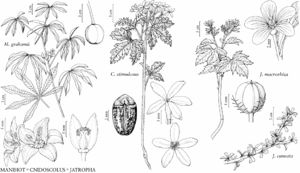Manihot
Gard. Dict. Abr. ed. 4, vol. 2. 1754.
| Taxon | Illustrator ⠉ | |
|---|---|---|
 | Cnidoscolus stimulosus Jatropha cuneata Jatropha macrorhiza Manihot grahamii | Barbara Alongi Barbara Alongi Barbara Alongi Barbara Alongi |
Herbs, subshrubs, shrubs, or trees, perennial, unarmed, usually monoecious, rarely dioecious; hairs unbranched or absent; latex white. Leaves persistent or deciduous, alternate, simple [palmately compound]; stipules present, deciduous; petiole present [rudimentary], glands absent; stipels present at apex; blade usually palmately lobed, rarely unlobed, lobes undivided or secondarily lobed, margins entire, repand, or serrate, laminar glands absent; venation palmate (pinnate in lobes). Inflorescences bisexual (pistillate flowers proximal, staminate distal), terminal or axillary, racemes or panicles; glands subtending each bract 0. Pedicels present, pistillate often elongating in fruit. Staminate flowers: sepals 5, petaloid, 7–20 mm, valvate, connate 1/2 length; petals 0; nectary intrastaminal, cushion-shaped, lobed; stamens (6–8) –10, in 2 whorls, distinct; pistillode absent. Pistillate flowers: sepals 5, petaloid, distinct; petals 0; nectary annular, lobed or unlobed; pistil 3-carpellate; styles 3, connate basally, unbranched, flabellate, prominently papillate. Fruits capsules. Seeds globose to oblong; caruncle present. x = 9.
Distribution
s United States, Mexico, Central America, South America
Discussion
Species ca. 100 (6 in the flora).
Manihot is one of the most economically important members of Euphorbiaceae, primarily because of the starchy food-bearing roots of M. esculenta, now cultivated throughout the tropics. Also, M. glaziovii Müller Arg., from northeastern Brazil, was once an important source of Ceará rubber. Manihot appears to be most closely related to Cnidoscolus, a conclusion supported by morphological (G. L. Webster 1994) and DNA sequence data (K. Wurdack et al. 2005). Four species of sect. Parvibracteatae, as defined by D. J. Rogers and S. G. Appan (1973), barely extend across the borders of Arizona and Texas from Mexico. In addition, two species are naturalized in the southeastern United States.
Leaf blade lobe characters (length, outline) are best developed in the median and immediately adjacent lobes; lateral lobes are progressively smaller and tend to have simpler outlines with distance from the median lobe.
Selected References
Lower Taxa
Key
| 1 | Shrubs or trees; inflorescences panicles; Gulf and Atlantic coastal plains. | > 2 |
| 2 | Leaf blade lobes without secondary lobes; stipules lanceolate, entire; stem nodes conspicuously swollen; leaf and stipule scars elevated, especially on older stems; capsules usually winged. | Manihot esculenta |
| 2 | Median and adjacent leaf blade lobes with secondary lobes, lateral lobes without secondary lobes; stipules linear, remotely serrate; stem nodes not swollen; leaf and stipule scars not elevated; capsules not winged. | Manihot grahamii |
| 1 | Herbs or subshrubs; inflorescences racemes; Texas and Arizona. | > 3 |
| 3 | Leaf blade secondary lobes acute, proximal; leaf blade margins remotely serrate. | > 4 |
| 4 | Leaf blade margins neither thickened nor revolute; inflorescences axillary; capsules finely tuberculate; s Arizona and adjacent Mexico. | Manihot angustiloba |
| 4 | Leaf blade margins thickened and revolute; inflorescences terminal; capsules smooth; s Texas and adjacent Mexico. | Manihot subspicata |
| 3 | Leaf blade secondary lobes rounded, distal or distal and proximal to middle; leaf blade margins entire. | > 5 |
| 5 | Leaf blades basally attached; staminate calyces campanulate; capsules nearly smooth; s Arizona and adjacent Mexico. | Manihot davisiae |
| 5 | Leaf blades peltate; staminate calyces tubular, midsection constricted; capsules verrucose-rugose; s Texas. | Manihot walkerae |
"elongating" is not a number."/2" is not declared as a valid unit of measurement for this property.